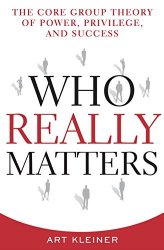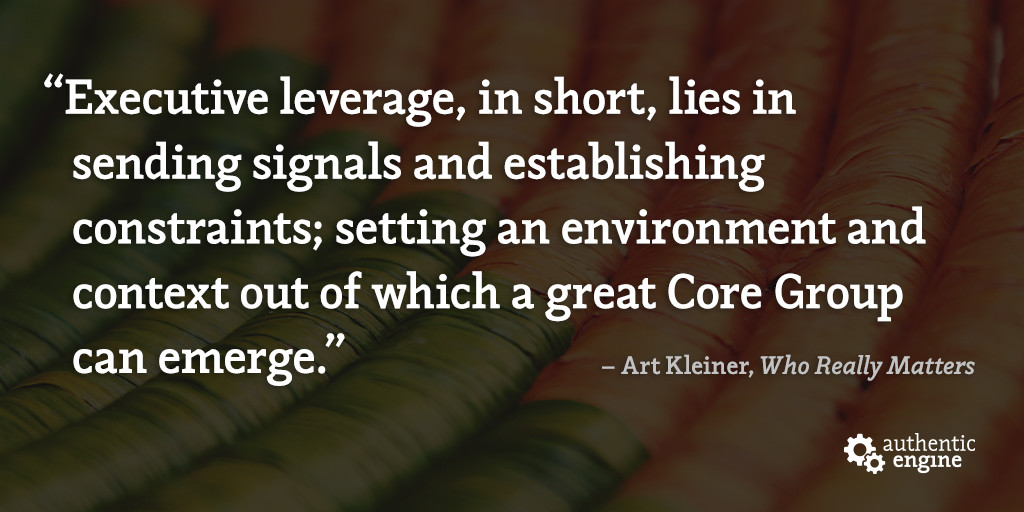
Summary: As CEO, you have formal authority, but it is constrained by guesswork as well as the priorities of the rest of the Core Group. The best way to use your power as CEO is to create the conditions out of which a great Core Group forms and operates.
Who Really Matters (Amazon, Goodreads, Powells) puts forth the theory that central to every organization is a Core Group of people who really matter.
This post is part of a series summarizing the book and covers Chapter 11: The CEOs Choices. You may want to start with the introduction.
Chapter 11: The CEOs choices
This chapter explores the factors that constrain your influence as CEO and how best to leverage that influence.
As CEO, you have formal authority, but it is constrained by guesswork because you can’t control how people will interpret your directives or how they will lead projects. You are also constrained by Core Group priorities. As CEO, you have influence over the Core Group, but not complete control. Even if you choose to override the priorities of the Core Group, doing so can have lasting negative consequences.
Building upon Peter Senge’s idea of “leader as designer,” Kleiner proposes that:
Executive leverage, in short, lies in sending signals and establishing constraints; setting an environment and context out of which a great Core Group can emerge. (p. 98)
That is, the best way to use your power as CEO is to create the conditions out of which a great Core Group forms and operates. As CEO, you can affect the following:
The paths by which people are recruited, promoted, trained, rewarded, and laid off. As CEO, you can’t hand select all members of the Core Group, but you can signal who you favor though the diversity and quality of people you promote and the kinds of training and development you support. If you want to see someone with a given background in the Core Group, build mechanisms for those kinds of people to be promoted up through the ranks. If you want to see someone with a given set of skills, create mechanisms for people to gain those skills on the job.
The visible ways in which senior executives pay attention and the channels through which that attention is made clear. Everyone else in the organization uses the attention of the Core Group to calibrate what forms of creativity, innovation, performance, and accountability are relevant. Whatever the Core Group pays attention to is what’s considered to be important. As CEO, you can encourage Core Group members to pay attention where needed. Especially important is to connect Core Group members and a wide base of creative people across organizational boundaries.
The patterns of information and communication flow. As CEO, you have significant influence over the information available to employees and also how employees communicate with each other. Focus on making sure communication from the Core Group is well-conceived, deliberate, and consistent. Doing so allows you and the Core Group to construct and share a complex, yet coherent worldview to guide the organization’s work. Also focus on connecting people across organizational lines because no one else is in a better position to do and it likely won’t happen otherwise.
The support given for entrepreneurialism and error. The best way to support innovation and creativity is to give people the freedom to say no to trivial requests and the freedom to experiment without fear negative consequences. As CEO, make it clear you and the rest of the Core Group support these two freedoms across your organization.
The quality of your own leadership. Embody, with maturity and presence, what you want your organization to be. Start by recognizing the privilege of your position and commitment it requires.
What’s Next?
Stay tuned for our next post in this series, a summary of Chapter 12: Expanded Core Group Organizations, which explores successful organizations that have an “expanded Core Group,” meaning nearly everyone is part of the Core Group.
Citations
Kleiner, Art. Who Really Matters: The Core Group Theory of Power, Privilege, and Success. 1st ed. New York: Currency/Doubleday, 2003.
This post is part of our Book Summary series in which we share summaries of books about leadership, governance, and community building. To discuss the book, leave a comment below or join our Goodreads group.


0 Comments